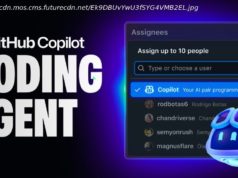The 7-inch Amazon Fire tablet doesn’t offer high-end specs or the latest apps, but it’s the best way to put a wealth of multimedia content at your fingertips for an almost unbelievable $50 price.
Amazon’s new $49.99 Fire 7 (8GB) is still the best tablet under $50, by a long shot. It’s particularly good as a portable video player, but at this nearly disposable price it’s also a shoo-in for a child’s first tablet. That said, Amazon has more than one new slate on the market, and the slightly more expensive Fire HD 8 ($79.99) is a better choice for most people, because more memory leads to better performance.
Not much has changed here from the original Fire. The new Fire 7 is a small tablet with big bezels clad in a matte plastic housing in colorful black, blue, red, or yellow. It measures 7.6 by 4.5 by 0.4 inches (HWD) and weighs 10.4 ounces. It fits nicely in one hand, and it’s heavy but manageable for book reading. By comparison, the Kindle Paperwhite weighs about 7.2 ounces.
The volume buttons, power button, and headphone jack are on the top of the tablet, along with a microSD port for charging and syncing. There’s a single, tinny mono speaker on the back. On the side, a port covers the microSD card slot. The whole thing isn’t technically ruggedized or waterproof, but it feels more sturdy than a lot of other tablets out there, and the tough plastic housing will save it from drops.
The 1,024-by-600,171ppi, 7-inch LCD is refreshingly bright, with a bit of a bluish tint to the whites. You can moderate the color balance using a built-in software blue light filter. The quality of the screen varies depending on what you use it for, though. For videos, gaming, and basic web browsing, it’s just fine. But for reading comics or digital magazines, we really prefer the Fire HD 8’s 1,280-by-800 (189ppi) screen. Small text looks pixelated and some magazine pages look cramped on the Fire 7’s display.
Amazon’s Fire tablet line, while Android compatible, are best thought of as Amazon media consumption devices. With a bit of work, you can turn them into general-purpose Android slates, but we think the Amazon restrictions can be a blessing in disguise: They prevent you from getting too frustrated with your inexpensive tech.
Amazon’s Fire OS is derived from Android, and it runs Android apps, but the basic UI is nothing like Android. If you love Amazon, there’s a lot to love here. The interface is much simpler and clearer than on most Android tablets, with bold words pointing the way to Books, Video, Games, Music, and Audiobooks. Your Amazon content library is automatically synced, loaded, and shown in every pane, and you have the option to stream or download content. Nearly every page tries to sell you something as well. This is Amazon, after all, so the company is guessing what you like and trying to provide more of it for you.
The OS comes with its own mapping, document reader, and email apps supporting the most common services and formats. To download apps, the tablet defaults to the Amazon Appstore. You can sideload other Android apps using APK files transferred from a PC or a microSD card, but there’s no official or reliable way to use the Google Play store on these tablets; there are hacks, but they tend to break when Amazon upgrades its OS. The Amazon Appstore has plenty of Android apps, but it’s missing some big names.
All of the Google apps (such as YouTube) are absent, as are some Microsoft Office apps, many popular mapping and transit apps such as Citymapper and Waze, any alternative web browsers such as Chrome and Firefox, and the American Airlines and Delta apps, for example. Of course, you can always go to the mobile sites, but it isn’t the same. We turned to a backup APK from a phone so we could load Marvel Unlimited.
By default, the lock screen shows colorful ads for products on Amazon. Right now, our unit is shifting between a clay mask kit and a 10,400mAh power bank (not the Anker one we recommend!) . You can get rid of those ads for $15.
There are some pluses to Amazon’s Android spin-off. Most notably, the kids’ content and parental controls are excellent, with a $2.99/month FreeTime Unlimited subscription service stuffed with age-appropriate books and videos, and a web dashboard for parents that lets you monitor and control the usage of up to four child accounts.
Amazon’s tablets now support Alexa, but without the always-on «Hey Alexa» functionality that makes the Echo so useful. You have to hold down the home button to voice search. You may be more likely to use the tablet as a place to read query results, as you can now tell your Echo to «send the answer to my Fire.»
The Fire 7 runs Fire OS 5.4, based on Android 5.1, on a 1.3GHz Mediatek processor. It benchmarks like a very low-end smartphone, and sometimes even worse, because I kept running up against the limits of its 1GB of RAM. One gig just isn’t enough for solid performance under Android any more, as I saw considerable lag in switching between applications and in loading and rendering icons in Fire OS’s graphics-heavy UI. Notably, I didn’t see this lag on the Fire HD 8, which uses the same processor but has 1.5GB of RAM—the extra RAM makes a big difference.
See How We Test Tablets
The RAM may also have played a role in the oddly slow Wi-Fi speeds I saw. The Fire 7 has dual-band Wi-Fi, which is absolutely needed nowadays. (2.4GHz Wi-Fi is so crowded in our test that it crawls on pretty much every device.) But the speeds we saw on 5GHz on the Fire 7 were often only half of what we saw on the Fire HD 8—once more, with the same processor and presumably the same Wi-Fi chips.
Battery life was fine, at 4 hours, 32 minutes of web video streaming on maximum brightness. You’ll probably get considerably longer usage time in Amazon’s own apps or Netflix, as the browser on the Fire tablets uses a lot of juice. For long road trips, invest in a 10,000mAh power bank like the Anker PowerCore 10000.
The Fire 7 comes in 8 and 16GB models. The 8GB model, which we reviewed, has very little storage available—only 5.63 GB—so it’s a good thing there’s also a memory card slot, and media and apps can be stored on a microSD card. Still, though, you should be aware that the base model can hold only two or three movies in its internal storage.
Movies look good, though. The Fire 7’s screen is quite bright for an ultra-low-cost tablet, and although it has a bit of a blue tint to the whites, that didn’t bother me in video playback.






